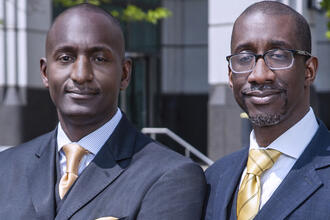
Oliver Sheldon, assistant professor of Management & Global Business at Rutgers Business School.
Business Insight: Manager biases may penalize racially diverse teams
In business schools, there’s a lot of discussion about the benefits of diversity in the workplace, especially among teams. But in the real world, the results are sometimes mixed.
Rutgers Business School professor Oliver Sheldon and his co-authors set out to see why.
In a short interview, Professor Sheldon discusses what they found.
Q: Why did you focus on how an outside bias might be hurting a diverse team?
A: "There’s been a lot of research done by academics trying to demonstrate the impact of diversity on a variety of things, creativity, decision making, team dynamics and that has shown a variety of positive effects diversity can have in those settings. But when it comes to field settings and organizations, there’s been some surveys and some work showing that diversity helps and there’s been a lot of other research that diversity doesn’t seem to have all of the positive effects researchers are finding in laboratories.
“Because of these mixed findings, researchers have started to look at other factors that may moderate the impact of diversity. We thought one reason you might be seeing a positive impact on diversity in laboratory settings or in carefully controlled research but not finding those same impacts in the field might be because outside evaluators or managers are potentially inhibiting the positive effects of diversity in some manner. We think that’s one potential factor of many that may impact whether a team succeeds or fails or whether those positive effects manifest or not.”
Q: How did you do the research?
A: "Our first goal in this research was to look at whether managers or outside observers perceive teams differently based upon their composition, their racial composition in particular. We decided to carry out some studies where we exposed observers, and in some cases, managers, to teams that were engaging in some task and that happened to be experiencing conflict. We wanted to see when those teams were racially diverse, did the observers perceive that conflict any differently than when those teams were racially homogenous.
“We did three studies, exposing outside observers or managers to teams that were diverse or homogenous and were all experiencing a little conflict. In particular, it was a little bit of personality conflict, very low level and kind of ambiguous. We chose conflict because it has been shown to have a negative impact on teams and performance. It is one thing outside observers might judge in deciding how to evaluate a team and how it’s functioning. By comparing outside observers’ perceptions of teams that were diverse versus homogeneous that were experiencing the same amount of conflict (the only thing that varied among the teams was their racial composition), we can see whether they perceive the conflict differently. We found across our studies that they did. When the team was racially diverse versus all black or all white, outside observers and managers perceived more conflict in the team and perceived the conflict as being more intense than when the team was racially homogenous. Incidentally, they also indicated they would treat racially diverse teams different, and more harshly, in response.”

Q: How does a company prevent these perceptions from hindering their teams?
A: "The first step is simply making managers aware that when they’re evaluating teams that have a racially diverse membership, it’s possible that they will form more extreme opinions of those teams. And so being aware of the bias may lead them to attach less weight to their initial judgements about how the team is performing. Other more structural things that organizations can do, training managers to develop some objective standards before they walk in to observe a team so they’re not biased in the moment by what they see. Or organizations can potentially disassociate. For example, they can have some outside evaluator who isn’t directly linked to the team, who doesn’t know all of the dynamics that are going on with the team, evaluate its performance. Essentially, trying to make the observers or evaluators blind to the composition of the team."
Q: Do teams have a role in helping themselves?
A: "Managers may not understand the source of the tension or disagreement that’s going on with a team. The disagreement may come from a good place, where the team is trying to work through things. Teams need to make it clear to managers when things are going well and when things aren’t, so they don’t leave those judgements up to managers."
In February, an article written by Sheldon and his co-authors on this research, “The biases that punish racially diverse teams,” appeared in the Harvard Business Review.
Press: For all media inquiries see our Media Kit


